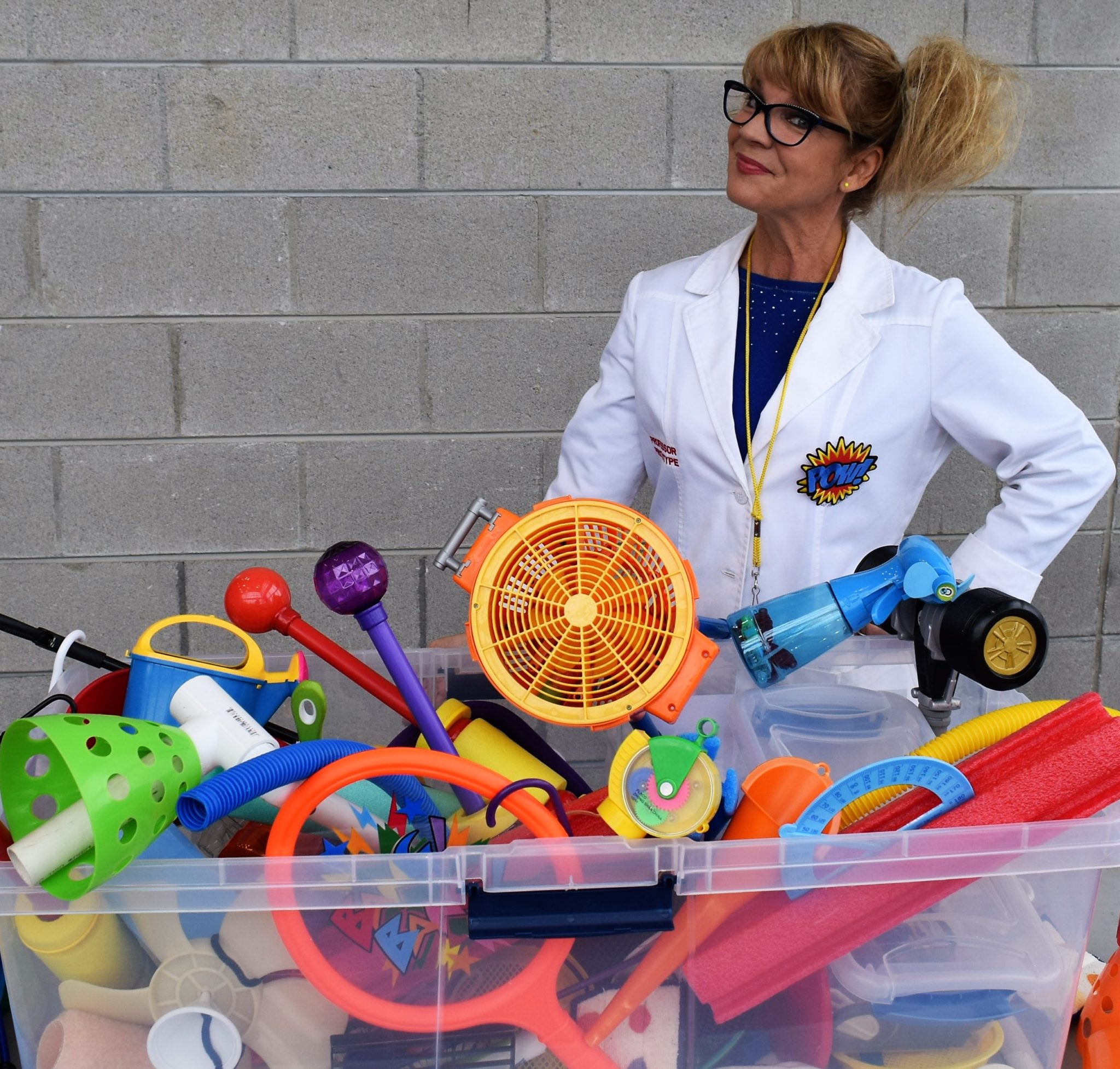Coping with food insecurity — a lack of access to sufficient, healthful food — is a daily challenge for many Ohioans, even in our agriculture-rich state. Solving this growing problem is the aim of the 2019 Ohio Design Challenge posed by the Ohio STEM Learning Network. OSLN has invited the state’s K-12 students to work in teams to design and prototype a solution to food security in their lives, community, or world.
Tackling a design challenge can be daunting for teachers. So our upcoming convening will guide educators through the process. The free event, set for October 18 at the Nationwide & Ohio Farm Bureau 4-H Center on Ohio State University’s Columbus campus, will inform teachers about food insecurity and how to align the design challenge to content standards and create prototypes.
| Important links | |
| Register to attend the convening | Sign up your school for the 2019 Ohio Design Challenge |
And, with prototypes in mind, the featured event speaker will be Abby Fisher, aka Professor Prototype, who is also programming director with the Invention League and the STEMIE Coalition. She gave us a preview of her speech and insights into her work with the Invention League:
Q: Tell us about your work with the STEMIE Coalition and the Invention League.

A: My work with the Invention League’s Ohio Invention Convention, state affiliate program for the STEMIE Coalition, and with STEMIE is to inspire youth in grades K-12 to activate their powers of creative and critical thinking, curiosity, perseverance, imagination, problem solving, determination and confidence by identifying a problem they see in their world and solving it using these powers and STEM skills through inventing.
We know every child can look at the world and ask, “What if?” and, “Why not?” They have the potential to see the world and a problem in a new way and impact their world through invention. The problems they identify often come from an empathetic place and a true desire to help improve a situation or alleviate challenges for someone they know or have observed.
We believe the earlier students start developing, activating and applying these skills the better. STEMIE believes, “What invention education brings to children is a way to leverage the other skills they’re learning and to use them to learn to solve problems. And the skill of problem solving, like any other skill, is one that needs to be practiced and exercised and built upon itself to become a mature, lifelong skill that can carry children into their future careers.”
The mission of both organizations is to “have every child become an inventor once, better twice, instilling creative problem-solving, analytical skills and critical thinking and confidence for life. STEMIE bridges STEM and Entrepreneurship to build an Innovation Ecosystem.”
Students present their inventions in school, district, state and at the National Invention Convention and Entrepreneurship Expo, held annually at the Henry Ford Museum of American Innovation in Dearborn, Michigan.
Professor Prototype appears in short videos to introduce each step in the invention process, as identified by STEMIE, for their national curricula available at no cost at www.inventionconvention.org.
The curriculum includes lessons plans under each step, by grade levels for K-12. I also make appearances at schools, events and competitions to inspire, congratulate and celebrate student inventors. I have been working with Invention League’s Ohio Invention Convention for 20 years and have shared the power and importance of problem solving through invention with tens of thousands of students. I work with our Ohio alumni inventors to provide further opportunities and promote the impact of invention education.
Q: How did the character of Professor Prototype come about and where does she appear?
A: My Professor Prototype character came out of Ohio’s assembly program for schools. I began appearing in schools in the late 1990s as Dr. Claire alongside Captain Gadget Q. Thinkamajig, sharing the invention convention opportunity with students through an interactive assembly and game show.
My character was created out of a desire to help young female students identify as STEM capable inventors. At that time, most science- and engineering-related hosts and characters were male. We knew if we wanted to inspire girls to participate in our program and excel in STEM, these female students needed to see themselves represented.
As we expanded to a statewide program for any school or student in Ohio, we moved to a video format to share Professor Prototype and Invention Convention. This allows us to reach all schools and students. We changed my character name in the 2016-17 school year to represent what we ask students to do — build a prototype.
Professor Prototype can be found at national and state conferences, schools, Ohio media appearances, Invention Convention competitions, the Ohio State Fair and at STEM-related events — often with our young inventors and their prototypes.
Q: What will Professor Prototype’s approach and goals be as the keynote speaker for the STEM teachers?

A: Professor Prototype’s approach will be fun, interactive, informative and, I hope, inspirational. I will be sharing how educators can help students identify and understand problems, realize the materials and resources available to aid their students in prototyping and how they can inspire and empower their students to prototype and create solutions to the problems they have identified.
Educators can take part in a group activity and take away resources and ideas for implementation in the classroom.
Q: How will your speech help the teachers prepare to assist students with the design challenge of increasing food security?
A: Through the sharing of resources, an interview with an actual student inventor on her prototyping experience and the interactive activity, educators will learn concrete ways they can assist their students in developing actual prototypes out of everyday items, maker spaces and technology within their schools. Most important, the speech will remind the teachers that their students are curious, creative and critical thinkers who can activate and develop their innate problem-solving powers and STEM skills to build interesting prototypes and solutions to solve problems related to food security.
Q: How do you think posing such design challenges, or engaging students in invention and entrepreneurship, helps both teachers and students grow in knowledge and experience?
A: Posing design challenges and engaging students in invention and entrepreneurship help both teachers and students by providing project-based learning opportunities where the STEM skills they are developing can be applied in a fun, motivating, natural way.
We learn the most when we are developing skills and applying them because we need to successfully complete a project or goal. Students seek out research because they need to understand the problem and identify ways to solve it. They need to collect data to understand the users and the people who will benefit from their solution, as well as understanding if their solution is really needed or beneficial. Students must access design thinking to create/design possible solutions and build a prototype. They must test and redesign to develop a unique and viable solution.
A truly valuable lesson is powering through failure. There is no right or wrong answer, and every attempt that doesn’t work isn’t a failure, but information collected to take into the next iteration.
Students are often afraid to fail or are inclined to quit something if success is not the first outcome. Design challenges and invention education help students to begin to see failure as not an end but part of the process in the journey, thus creating more resilient learners and more capable workers for our ever-changing, problem-solving-centered future workforce. Students who might not identify as proficient and interested in STEM can be reached through these opportunities as well.
Ask a room of students if they like science, math and engineering, and often the ones who have had success or been identified as strong in these areas typically raise their hands. Ask a room of students if they see problems in the world, if they are creative, if they like to build things and help people, and a lot more hands go up.
It’s one of the beautiful things of inventing and design challenges — students realize they used STEM skills as a result, were successful and enjoyed it. They get empowered and gain confidence, and that is helpful to a student in any endeavor.
Q: How can educators get more information on the STEMIE Coalition and the Invention League?
A: Educators can learn more about the Invention League’s Ohio Invention Convention at www.inventionleague.org or by emailing [email protected], and The STEMIE Coalition at www.stemie.org.
They can follow us on Facebook and Twitter: @inventionleague and @STEMIECoalition.